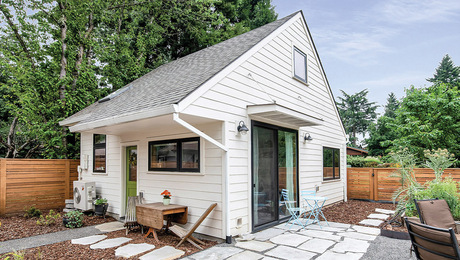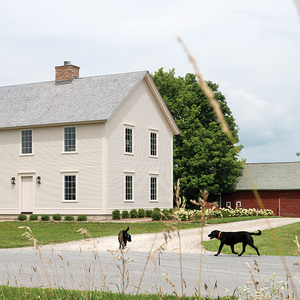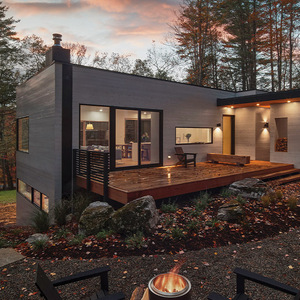18 years ago I built a very sturdy house. The house has many aluminum sliding doors and windopws. In a neighboring large abutting lot, a new school was built. They used pile drivers and compacting machines for two years. The vibrations were so strong they shook glasses from our shelves and some of the windows cracked. All the sliding doors and windows move with difficulty or not at all. The house has oversized headers, the plaster on the walls have not cracked….what has happened and how do I correct the problem. Help!
Edited 10/25/2005 2:03 am ET by HyGene



















Replies
The question is whether vibration can compromise the openings and if so how.
Thank you so much for your insight. I am new to this web site and I hope that my thank you will reach you. Sincerely [email protected].
I agree with 4Lorn that the dirt work on the adjacent property could have caused settling on yours, but I don't think your insurer would be the first call. Instead I would have a geotech engineer review the soil conditions on your site, the foundation you have, and the work that was done adjacent. Depending on the findings I would call either your attorney or the school district's insurance company, or both.
They agree that the vibrations radiated from the compacting machines and that there were many complaints. But the foundation has not cracked and they are prepared to turn their backs until we give them a reason why the doors and windows will not slide since there is no visible signs of stress. I know we will need an engineer to confirm the extent of the vibrations.... but the greatest problem at this point in time is to get some idea as to what and why the openings were compromised when there are no visible cracks. Wonder what vibrations will do to the nails that keep the wood from torquing sideways. Thanks, Gene
You're 100% sure the foundation hasn't cracked? I'm guessing you just haven't found/recognized the cracks.--------------
No electrons were harmed in the making of this post.
I'm not even sure the foundation would have to crack, I think the compaction of the neighboring site could simply cause settling and maybe the cracks come later. I also do not think the settling would have to cause drywall cracks, because I have done a lot of jacking under plaster and drywall finishes and you can move a wall enough to affect a door or window without cracking the finish.
It would not take much settling to affect the operation of aluminum windows or sliders. It will probably be difficult to demonstrate the before/after of the situation so that there's no doubt. I'm not a lawyer but I suspect this would be a situation where the opposing party would settle to avoid further action.
That is interesting. You are correct! Plaster and sheet rock can accept some stress without cracking! There is no question that vibration does expand the nail holes and that the plaster does compensate. Then, what is it in the framing and positioning of the aluminum units which can compromise the ability to glide after repeated and constant vibrations. We know the units have limited tolerance...that is true. But the fact that all the units in all floors exhibit the stress....something that is common to all would have to be the issue.... It seems to me the vibration...torque...shift...would have to be the culprit more so than the settlement issue.
I probably did not read your initial post carefully enough. You are saying that all of the units are equally affected? I was assuming that most of the problem would be on one or two sides, closest to the construction site, and that settling would have occurred on those sides. Back to the drawing board. Maybe the vibration was ultrasonic and degraded the plastic rollers in the window units?!
I was not clear. Every unit is affected...but some more dramatically than others. Some can be opened with great pull pressure, while others need enough pull to cause a separation of glass from the metal frame. The resistance seems proportional to the opening size... The eight foot sliders are certainly more compromised than the conventional six foot units. But the difficulty of slide is even found on the sliding 30 inch height windows. Even more unsettling is that cracks in the gas appeared in the 30 inch sliding windows and then,actual breakup of the tempered glass, in a 3 foot slider panel. I think...... earth quake vibrations actual cause fissures in the earth. Since the foundation appears intact and.... settlement ,if any, must have been uniform.....I begin to believe that the difficulty is in twist and distortion...but I have found no written basis or any pre-existing examples anywhere.Certainly repairs can't be made until I have an idea of what has to be repaired and why something has to be repaired. Gene
I think the foundation would have to "deform" -- one part moving up/down/sideways faster than another. Yes, in theory the framing could simply rack, but there's a lot of plaster and siding and whatnot working against that -- staying "upright" is the path of least resistance. So presumably some force is acting on the framing, and uneven foundation movement would by far be the most likely force.Certainly this could occur without major, highly obvious cracks, but I would expect some signs of cracking (probably due to settling) somewhere in the foundation.--------------
No electrons were harmed in the making of this post.
Gene, another couple of questions: what is your soil like, and what is the closest to your building that this compacting was done?Dan, I know that concrete has some flexibility... how much I don't know, but I have seen it bend without cracking much. I once worked on a house that had an underground creek flowing under it and also against the foundation. When you sighted down the foundation from one end to the other, there was an inward bow of a couple of inches that had formed over the 50+ years the house had been sitting there with water flowing against it. No cracks on the inside. Perhaps Gene's house could have settling going on with no cracks... yet?
as most of yall now, I work for a testing lab. We are usually doing test on pile driving daily. sometime in tight area we also montior vibration of nearby structure, using computers. although shaking can be felt and some item might fall off shelf, this is no way to measure damage. A truck going up the highway can do the same. I have gauges set right now that measure a thousand of an inch. within 100 feet of a pile rig putting in 72 feet concrete pile with a diesel hammer. and minor movement can be monitor. Out of 22 years testing pile rigs, I have yet to have one do damage to nearby property. It would have to be within fifty feet, and then the subject come up. was your residents on uncompacted material to begin with. This brings up the topic that a corrected compacted subsoil would not settle no matter what force was nearby. If they are driving pile nearby, this could mean that unsuitable soil are in your area too. expansion clays, muclh, uncompacted silts.you can buy settlment gauge cheap, its like a plastic tape where one side moves and the other doesnt. This is usually on cracks. I really doubt the contractor will even talk to you. it seems like everytime a pile rig start working, people come out of the woodwork claiming settlement. If you worry about things on shelfs, take them off selfs.Out of 22 years, I have never known for a pile company to pay damages. If you need to talk to somebody, that would be the engineer on site, not the GC, owner, or pile rig. The engineer has exprience in monioring damaging vibration.I dont mean to start a fight or question your opinion, just wanted to state the idea, that the pile rig might not be the problem.
Yeah, my guess is uncompacted soil. In residential construction (sans basement) they generally just dig down to the frostline, or to undisturbed soil, whichever is deeper. No mechanical compaction is done, And if the lot is regraded, this might not take them down to "mineral" soil. Enough vibration could cause organic soil to compact substantially.
--------------
No electrons were harmed in the making of this post.
I don't mean to be a wet blanket but my experience is similar to brownbagg's. I don't do testing but I have been called to evaluate many cases where nearby construction vibration (even explosions) have been suspected of causing building distress. I'm not questioning or second guessing the observations you have made. I just would re-iterate that my experience is that (even thought it may seem obvious) it is extremely difficult to draw the connection between building distress such as you have described and the vibration from pile driving to such an extent that you can recover damages.
In other words, you've'e got an uphill battle ahead of you but good luck.
Surprisingly the compacting machine that they used caused more trauma than the pile driver. The house really shook. I understand that there is some unusual land formation in the area. The fact that glass within the frames either cracked or shattered is indicative of some stress. I believe that this situation may be unique to aluminum installation and might not have occurred with wood frame units. That is really the reason for my discussions. I am trying to get some idea as to what couold have happened to the aluminum units to cause them all to react so abnormally.
You say that you have had experience in assessing the stress from compactors and pile drivers. In this case the vibrations were very very strong over long periods of time. Window glass was definitely cracked, and a sliding door panel shattered. Every unit in the house is compromised. How can you explain this? The units functioned for years without problem. Have you had any experience where aluminum or metal units become compromised by settlement or torque or stress? The fact is that all units were operative for years and all developed the problem of glide during the prolonged work in progress. I begin to believe that wooden or plastic frames might be able to compensate but aluminum may not be able to recover. Maybe the slight twisting and turning combined with a slight compaction distorts the metal framing. Was hoping I could hear from someone who has encountered a similar situation. Gene
Many years ago my dad (a lawyer) handled claims for Texas Eastern transmission company, a gas pipeline company. He handled hundreds of claims, and most were as you say, hard to pin on a particular cause (and often just routine foundation cracks that had been there for years).But he did tell me he handled one case where there had been blasting, and the person had some fairly obvious damage, with pretty good before/after evidence. My father advised the company to settle for the claimed amount.What can happen is that various soil and rock formation conditions can combine to focus vibrational energy is a small area, causing significant damage, when slightly different conditions would have resulted in nothing unusual.
--------------
No electrons were harmed in the making of this post.
You bring up some interesting points...The issues here are that there are no plaster cracks in the house.There are no foundation cracks. The soil under the 12 inch poured 8 foot high foundation was sandy clay and solid material perfect for building. The pile driving did not vibrate the house as much as did the compactor. The operations continued over a two year span. I was told that there is a fault on the property where the work is being done and the soil there transmits the vibration with unusual severity. Remember that there was cracking of panes of glass so something was going on. Every single unit...sliding doors or sliding windows no longer glide freely. What ever happened was not restricted to a specific area. A section of the house is one story and a section is basement and two stories. Yet the compromise in inability to glide and slide... presents all over.
Could the combination of continual vibration with minor uniform compaction settlement, in some way, compromised the aluminum? There may not be a tolerance in aluiminum that one could find in wood or plastic framed units.
In your past experience have you ever encountered problems in iron and/or aluiminum installations abutting a site where you operated for ####long period....either pile driving and/or compacting? Gene
Sounds like a problem with racking. Oversized headers don't do much to prevent this. The best, as far as I can tell is complete sheathing of the framing with OSB or plywood, the later being IMHO slightly better but either is generally accepted as adequate.
You should be able to check for racking by measuring the diagonals of the units that don't work smoothly.
A possible solution would be to remove any trim and caulk, remove or saw through the mounting nails or screws and, after freeing up the units, reshim them in the rough opening to allow the windows and doors to regain their functional geometry. The trim, finish and caulk would then need to be replaced.
Settling could also be an issue but this tends to demand professional help to stabilize the foundation and structure. Once the situation was stabilized the units could be repositioned as above.
You may wish to consult with the your insurance company. If the nearby construction cause the problems there may be some way to recover some of your expenses. As I understand it most municipal projects carry insurance for this sort of contingency. Heavy construction on a site is not infrequently a cause of issues on nearby properties so your wouldn't be a unique situation.
You probably should file a claim with their insurance co. An attorney would likely be necessary.
No electrons were harmed in the making of this post.
Thank you for your suggestion. I have talked to their insurance carrier and get only gobblegook. 4Lorn1 indicated that the problem may be racking. This seems to make sense since I had heard that vibration loosens nails. He suggested that I measure the diagonals and I will do that. My concern is that despite the fact that every door and window in all floors have been compromised, the plaster has not cracked anywhere. I would like to know a potential cause so that I can arrange a reliable repair program, determine what and how and then confront the insurance and/or an attorney. But at this point in time I have had extreme vibrations over long periods of time, breaking glass, dishes and glasses being knocked off shelves...no apparent sag in the headers, no cracking of the plaster and every single unit either impossible or difficult to slide. What a conundrum. Thanks for any help. Gene
Assuming the house was well constructed, there shouldn't be any racking unless there is uneven settling in the foundation. This will be evident in the presence of significant cracks. If there are no cracks, there is no uneven settling.
I would look to the mechanisms that allow the windows/doors to slide. The vibrations could have caused these to deteriorate. Possibly dust has worked its way into the mechanisms and caused them to bind. It is possible that cleaning out and lubricating can help you with the problem. In any event it is easy to try, as opposed to unwracking your house. Good luck and keep us informed as to what you find out.
18 year old aluminum windows & doors are near or past the end of the life expectancy for the operating hardware & normally the glass as well. Dust may be a culprit but I'm more inclined to say it's time more than anything. It will be intersting to see what is discovered.
Unfortunately all of the aluminum units are pressure bound....That is...the sliding windows as well as the sliding doors.I believe no panel can be removed easily as each seem to be bound or jammed. Yet I know the headers to be oversized and there should not be a sag in the rough opening. The foundation is 12 inch thick on firm clay- sand, the frame is exceptionally well designed. 2x4 frame, closed with plywood and then 1x6 v joint pine vertically and with final finish, horizontal prestained clapboard. Yet this house was rocking and rolling from the vibrations when the compactor was operating. Whatever was happening made opening and closing windows and doors progressively worse so that every opening is so compromised so as to be effectively non operative. I assume that there is only limited clearance provided for the roll of door and window...but the question is what caused that narrow space to be compromised enough to make all the units too jammed to roll freely? There has to be a common denominator....and what that could be is my question.
Well, it should be a simple matter to take a square to some of the windows. Or just check the fit of the sashes as they close.--------------
No electrons were harmed in the making of this post.
I wish it was as simply determining whether it is square. The tolerances are apparently very small. I assume about a 1/4 inch. The issue becomes what is causing the pressure that compromises the gliding. Is it a sag or a twist or a combination. Since every unit suffers from the same symptons...We know there has been some compaction and settlement...but not enough to crack the foundation. We know there has been some twisting since there has been cracking of glass and fracturing of glass. And apparently the combination of these stresses have compromised the units. I assume I will have to eventually cut out the units and replace. My concern at this point is to come up with a reasonable diagnosis as to what caused the problem.
Heck, 1/4 inch is easy to detect.First, on a window where the sash has not been damaged, lower the sash down until you can just see daylight between it and the lower trim. If the slit you see is not an even height all the way across, the window is racked.To check for a frame that's been compressed inward, get a couple of thin sticks a couple of inches shorter than the frame width & rubber-band them together. Pick a place in the frame cross-section (in the track is ideal) where you're going to measure. With the sticks held horizontally in the middle (halfway between top and bottom) adjust them until they just touch the sides, then move the sticks to the top and bottom. If there's a gap when the sticks are held at the top or bottom, the frame is being compressed inward.For the final check, tape a piece of string diagonally from the top right to the bottom left, tape another piece at the top left, leaving the bottom end loose. As you move the loose end in towards the bottom right, the strings should just kiss as the loose end is two string thicknesses from touching the frame. If not, then the frame is not flat. (Note that this check is ideally done between points on the frame proper, and not on the trim, since the wall thickness may keep the trim from sitting flat.)Generally, you'd have to work pretty hard to cause a frame to be compressed inward due to foundation settling. If this is occurring then it's probably a window installation problem or perhaps insulation between the frame and rough opening has settled and is pressing the frame inward.
--------------
No electrons were harmed in the making of this post.
There is no question that something is either out of square, is slightly twisted, is compressed, or compromised ....since no unit glides freely. I have no doubt that the only solution will be the removal of the units, adjusting any deformities in the rough opening...if there are any, and then resetting new units. The aluminum old units must be stressed so they should not be reused or reset. Whatever malformation exists will probably not be corrected by simply resetting the existing frames since metal has no snap back potential.. The doors and windows themselves will have to be replaced because the track hardware varies with manufacturer and these units are 18 years old. Therefore, I guess what I really need answered is... what the vibration could have done to effectively total all these units. I had a response from a person who had experience in earth compaction and pile driving who insists that the rocking and rolling will compromise nothing and I should look elsewhere for the culprit. Somehow this does not seem reasonable in my mind since glass was shattered during vibration. Wonder if this phenomena occurs only in aluminum and would not occur in wood framed sliders. Ah well back to the drawing board.
Gene
You cant get one slider out to see what might be the problem?
If you could do that it would help.